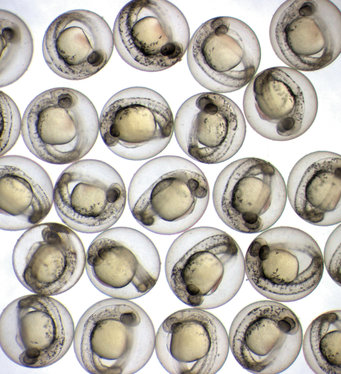
Why do researchers investigate zebrafish?
Strong genetic similarity to mammals
As a vertebrate, the zebrafish possesses many genes that perform the same or similar functions in mammals and therefore also in humans. Approximately 70 percent of zebrafish genes are also present in a similar form in humans. Over 80 percent of genes that are known to trigger disease in humans are also present in this fish. The zebrafish is therefore a suitable model organism for studying diseases suffered by humans.
Species-specific care

Keeping zebrafish in accordance with their needs is easier than with mammals such as mice or rats. In the wild, they colonize streams, ponds and paddy fields and do not make strong demands in terms of habitat and water quality. They also live in schools and do not cultivate territories that they have to defend. They are therefore easy to keep in large numbers in aquariums.
High level of fertility and fast development

A zebrafish couple can produce 300 eggs per week. The larvae hatch two days after fertilization; five days later all the vital organs are in place and have taken up their work. Just two to three months later, the young fish have reached sexual maturity and are themselves capable of breeding new offspring.
The speed at which the zebrafish reproduces makes research much easier for scientists. In order to understand how a gene works, scientists must modify the gene. Until recently, this was just a matter of chance and needed a large number of animals, as experience shows that only a few animals carry the required mutation.
A rapid life cycle is also a major advantage for researchers who study the development of an organism from the ovum to the adult animal. The development steps that take one month for a human embryo are gone through by a zebrafish embryo in one day – an enormous time saving for scientists.
Easy to study
The splendid colour of the adult fish starts to appear from the third week; the zebrafish larvae, in contrast, are almost completely transparent. Using microscopes, researchers can therefore look into the bodies of animals up to six weeks old without having to injure the animals.
Slight genetic variability
Like all fish, zebrafish absorb dissolved substances from the water. Scientists can benefit from this characteristic by adding substances to the water that modify the genetic material, for example, and then analyzing the effects of the mutations. Genes can also be turned on or off directly in genetically modified fish by adding various substances. It is also comparatively easy for scientists to perform tests on the toxicity of new substances or on the side effects of medications on the fish. As the fish larvae can survive in very small containers of less than one millilitre, it means that a large number of substances can be tested in the minimum amount of space.













